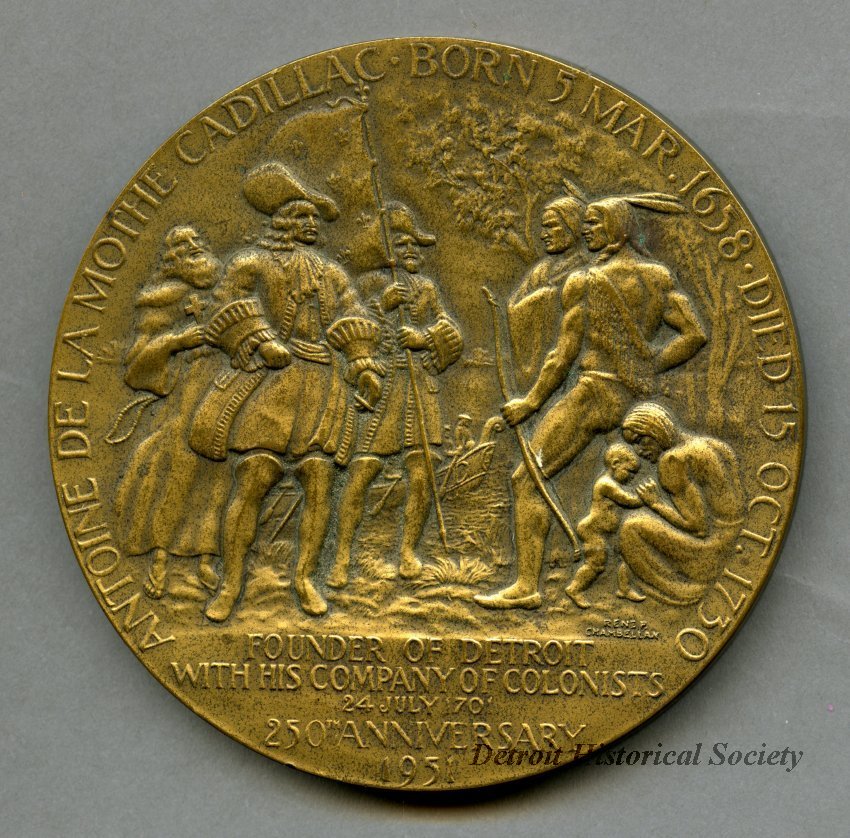The site that was to become the city of Detroit was established on July 24, 1701 by Antoine de la mothe Cadillac, a French military leader and trader. Cadillac had traveled widely in New France and the western Great Lakes and was the commander of Fort Michilimackinac at the junction of Lakes Huron and Michigan.
In 1698, Cadillac returned to France to petition King Louis XIV for authorization to establish a French outpost along “le détroit” (the strait), the waterway connecting Lakes Erie and Huron. In 1700, Cadillac successfully persuaded the king’s minister of marine, Jérôme Phélypeaux Comte de Pontchartrain, to authorize an expedition to establish not a post, but a settlement. Cadillac hoped to forestall British attempts to occupy a nearby area, as well as start a colony that could survive on the rich soil and fur trapping opportunities of the region. Although it would be the first European settlement in the area, Indigenous Anishinaabe peoples had been living in and caring for the region for thousands of years extending back to their Ancestors.
Cadillac’s entourage of soldiers, missionaries and colonists set out from Montreal on June 5, 1701, led by indispensable Native guides. The expedition traveled by way of the Ottawa River, through Lake Nipissing, out down French River into Georgian Bay, Lake Huron, St. Clair River, Lake St. Clair, and finally the Detroit River, stopping for the night on Grosse Ile on July 23rd.
The next day the flotilla of 25 boats returned upstream. They chose the narrowest part of the river, on a high point of the north shore, unfettered by any island and thereby easy to defend, as the site for Fort Pontchartrain, in honor of the French marine minister who approved their trip. The full name, Fort Pontchartrain du détroit, gave Detroit its French name. The area had been known by many names to various Indigenous peoples, including Waawiiyaataanong, meaning "where the river bends." Two days later, on July 26, Saint Anne’s Day, they begin building a chapel named in her honor, the first Ste. Anne’s Church. By September the first European women arrived, Madame Cadillac and Madame Tonty, the wife of Cadillac’s first lieutenant.
Beginning in 1707, Cadillac awarded farms to settlers that extended two or three miles inland and were laid out with narrow river frontage. These uniquely designed plots were known as “ribbon farms” some of whose boundaries are identified today by streets named for the early French settlers.
Native peoples like the Odawa, Bodewadmi, and Ojibwe were encouraged to settle around the fort for mutual protection and to facilitate the fur trade. The area's Native and French populations even joined each others' families through marriage. However, the mix of different tribes was not always peaceful and growth of the settlement was stunted by Cadillac’s unpopularity. When he was made governor of Louisiana in 1710 the attention of his sponsor, Pontchartrain, waned.
During the next 50 years, Detroit remained a small frontier settlement made up of soldiers, artisans, trappers, hunters, farmers and traders with an economy centered on fur trade and farming. The entire village, including the stockade, streets and buildings, occupied an area of only one city block, bordered by the present-day streets of Griswold, Fort, Shelby and Larned and was known as Fort Detroit, beginning in 1751. Despite the settlement, the region's Native peoples far outnumbered the Europeans. The village of Detroit remained a French settlement until a British takeover in 1760, following the French and Indian War.

